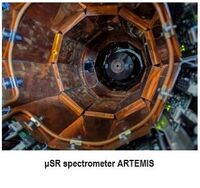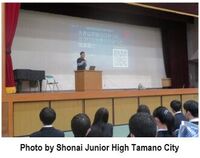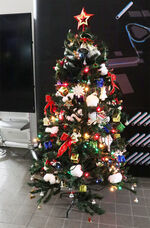J-PARC News January 2024 (Issue #224)
■Best Presentation Awards of Japan Society of Radiation Safety Management Received (November 13th)
The Japanese Society of Radiation Safety Management 22nd Annual Meeting took place in Shizuoka prefecture on November 13th. At this event, Chief, Koichi Sakashita and Chief, Saori Kato from the Radiation Control Section of J-PARC were honored with the Best Presentation Awards for delivering the most outstanding oral presentations.
The title of Chief, Sakashita's presentation was "Evaluation of Radioactivity Conversion Factors of Scintillation Gas Monitors Used for Measurement of Short-Lived Nuclides Generated in Hot Cells at Materials and Life Science Experimental Facility of J-PARC". He presented that simulations of radiation behavior in the monitors were utilized to assess their response to short-lived radioactive gases generated within the air. Chief, Sakashita said, "The attendees' questions about the significance and practical implications of our results in radiation control prompted me to give an enriching presentation, complete with a question-and-answer session to answer their questions.”
Chief, Kato's presentation was entitled "Producing Videos to Preserve Knowledge on Accidental Radioactive Material Releases”. She played a key role in the production of three educational videos aimed at providing lessons learned from past accidents. During her presentation, she introduced the content of the videos. Chief, Kato expressed, "I hope this award will serve as motivation for us to prevent the fading memory of accidents by applying the lessons learned to ensure the safe management of radiation.”
■Exploring Transient Phenomena with High-Intensity Pulsed Muons - Development of the Transient µSR Method (November 16th)
Scientists at J-PARC have developed a new technique, named "transient µSR," to improve muon spin rotation/relaxation (µSR) experiments. In this method, information such as sample temperature, magnetic field, and μSR data are integrated in real time for each muon pulse to generate multidimensional data. This allows researchers to change the sample environment without interrupting data collection. Original software has also been developed to allow a wide range of J-PARC users to easily handle the multi-dimensional data. With this innovation, continuous µSR measurements are possible even when the sample itself undergoes gradual change with time, resulting in more efficient use of the beam. The transient µSR method is expected to accelerate the study of transient phenomena, such as non-destructive measurements of battery under operation.
For further details, kindly refer to our official website.https://j-parc.jp/c/press-release/2023/11/16001238.html (only in Japanese)
DOI: https://doi.org/10.1016/j.nima.2023.168669
■Reproducing Silica Glass Structure with Atomic Simulation - Exploring Sharp Peaks & Atomic Patterns with Advanced Molecular Dynamics (November 16th)
The atomic structure of glass has long been thought to be disordered because the atomic arrangement of the liquid is frozen, even though glass is a solid. However, in silica glass, sharp diffraction peaks (FSDP) have been observed in neutron and X-ray diffraction data, suggesting that a certain ordered structure may exist within the disordered structure. Glass does not have a periodicity of its atomic arrangement like crystals, so it is impossible to directly determine its complex structure from diffraction data.
To solve this problem, the researchers created a neural network potential using machine learning to learn the results of first-principles calculations of various silica crystals and liquids because the potential allows us to perform molecular dynamics simulations with high accuracy. By performing the machine learning molecular dynamics simulation for silica glass, the researchers succeeded in reproducing neutron and X-ray diffraction data taken by "NOVA" of MLF at J-PARC and "BL-04B2" of SPring-8, respectively, with high accuracy over a wide Q (momentum transfer) range. Consequently, the origin of FSDP and ordered structure, and the effects of densification and heat treatment on the ordered structure of silica glass were elucidated.
By combining this novel simulation technique with precise experimental data from J-PARC, we were able to understand the "medium-range ordered structure" in glass at the atomic level. The detailed analysis of silica glass from this study could aid in the development of new glass materials which enable faster and more efficient information transfer.
For further details, kindly refer to our official website.https://j-parc.jp/c/press-release/2023/11/16001239.html (only in Japanese)
DOI:https://doi.org/10.1038/s41598-023-44732-0
■Unveiling Unique Conduction Mechanism in a New Type of Perovskite Oxide -Stability, Conductivity, and Clean Energy Potential (November 17th)
A research team led by Professor Masatomo Yashima of the Tokyo Institute of Technology has discovered an oxide with promising dual-ion conductivity. This compound shows potential for use in clean energy technology, addressing challenges faced by current devices such as solid oxide fuel cells (SOFCs) and proton ceramic fuel cells (PCFCs).
This material is distinguished by its ability to efficiently conduct protons and oxide ions at lower temperatures, unlike many existing oxide ion conductors used in SOFCs. It combines the strengths of both SOFCs and PCFCs and offers a solution to their operational limitations.
The research team studied variations of this material and found a composition with exceptional conductivities that outperformed similar compounds. They used advanced techniques such as molecular simulations and neutron experiments to understand the mechanisms behind its high conductivity.
The team discovered that the material's exceptional conductivity results from a unique structural phenomenon that facilitates the rapid movement of ions. In addition, efficient proton migration within the material contributes significantly to its high conductivity.
These findings underscore the potential of dual-ion conductors associated with perovskite compounds and provide valuable insights for the development of superior materials in this field. Professor Yashima hopes that these discoveries will advance the science and engineering of ion conductors for future energy technologies, with this newly discovered oxide showing promise in this pursuit.
For further details, kindly refer to our official website. https://j-parc.jp/c/en/press-release/2023/11/17001241.html
DOI: 10.1021/acs.chemmater.3c02378
■J-PARC Public Lecture 2023 "THE MUONS FOR THE FUTURE - Seeing the Invisible!" on November 25th
A lecture organized by the J-PARC Center, Tokai Village, and the Tokai Village Board of Education was held at the Tokai Cultural Center.
After opening remarks by the Director of the J-PARC Center and the Mayor of Tokai Village, Dr. Izumi Umegaki of the Muon Section explained the basic properties of muons and reported the research results on muon-based analysis of batteries at J-PARC. Next, Yuta Nakai-zumi and Keiko Hayashi, curators of the Tokai Village Museum, introduced a project using cosmic ray muons, in which local students from elementary to high school collaborate to observe the ancient mounds of Tokai Village.
In the final presentation, Professor Tomoki Nakamura of the Graduate School of Tohoku University talked about the results of analyses of the asteroid samples using J-PARC's muon beam. The samples were recovered from the asteroid Ryuguby the Hayabusa2 spacecraft. The event was attended by 168 on-site participants and 72 online participants, who engaged in lively discussions during the Q&A sessions following each presentation.
The archive of J-PARC Lecture 2023 is available at the following link.https://www.youtube.com/watch?v=TYjuEH3wLrQ
■"Muographic Investigation of Ancient Burial Mounds in Tokai" Project Starts Assembling Muon Detector on November 19th
The club formed in October for this project has finally begun its biggest mission, the fabrication of a muon measuring instrument.
At the Tokai Village Museum, 18 elementary to high school students came together and were split into two groups. They teamed up to assemble detectors, aiming to observe cosmic ray muons as they pass through an ancient tomb. The task requires patience and concentration as hundreds of 1mm-diameter thin optical fibers are threaded through a 60cm long and 1m wide detector to attach the optical sensor. The children first read the instructions and then tackled the task with assistance from experts and Ibaraki University students for three hours. It will still take several more months to complete the detector. An operational test of the detector is planned to be conducted by the end of this fiscal year.
■Director Gives a Lecture at Syonai Junior High School in Okayama Prefecture (November 10th)
J-PARC Center Director Takashi Kobayashi delivered a lecture titled "Secrets of the Big Universe, Secrets of the Microscopic World, and Accelerators" at Syonai Junior High School in Okayama Prefecture. Around a hundred first-year students attended the lecture.
■J-PARC's Classes on Demand at Kagawa National College of Technology on November 20 (November 20th)
Dr. Masashi Otani from the Accelerator Section delivered a lecture titled 'Structure of the Accelerator for Observing the Microscopic World.' A total of 86 students attended and provided feedback, expressing a heightened interest in exploring the possibilities and practical applications of elementary particles, extending beyond muons. They also displayed considerable curiosity about the process involved in extracting protons for proton beams.
■Sanpomichi ㊶ - Christmas Tree at J-PARC Research Building
Amid scientific pursuits at J-PARC, December signals a subtle shift. A modest Christmas tree quietly stands on the first floor, overlooked by the morning rush of staff absorbed in their tasks. Within these walls dedicated to knowledge, seasonal changes often go unnoticed.
As December's early nights fall, staff leaving notice the tree's humble lights in the dim hall. Though lacking city grandeur or home warmth, its steadfast presence subtly influences the mood of those leaving.
This silent tree serves as a reminder amid scientific rigor, offering a touch of seasonal cheer to dedicated staff heading home on December evenings.








